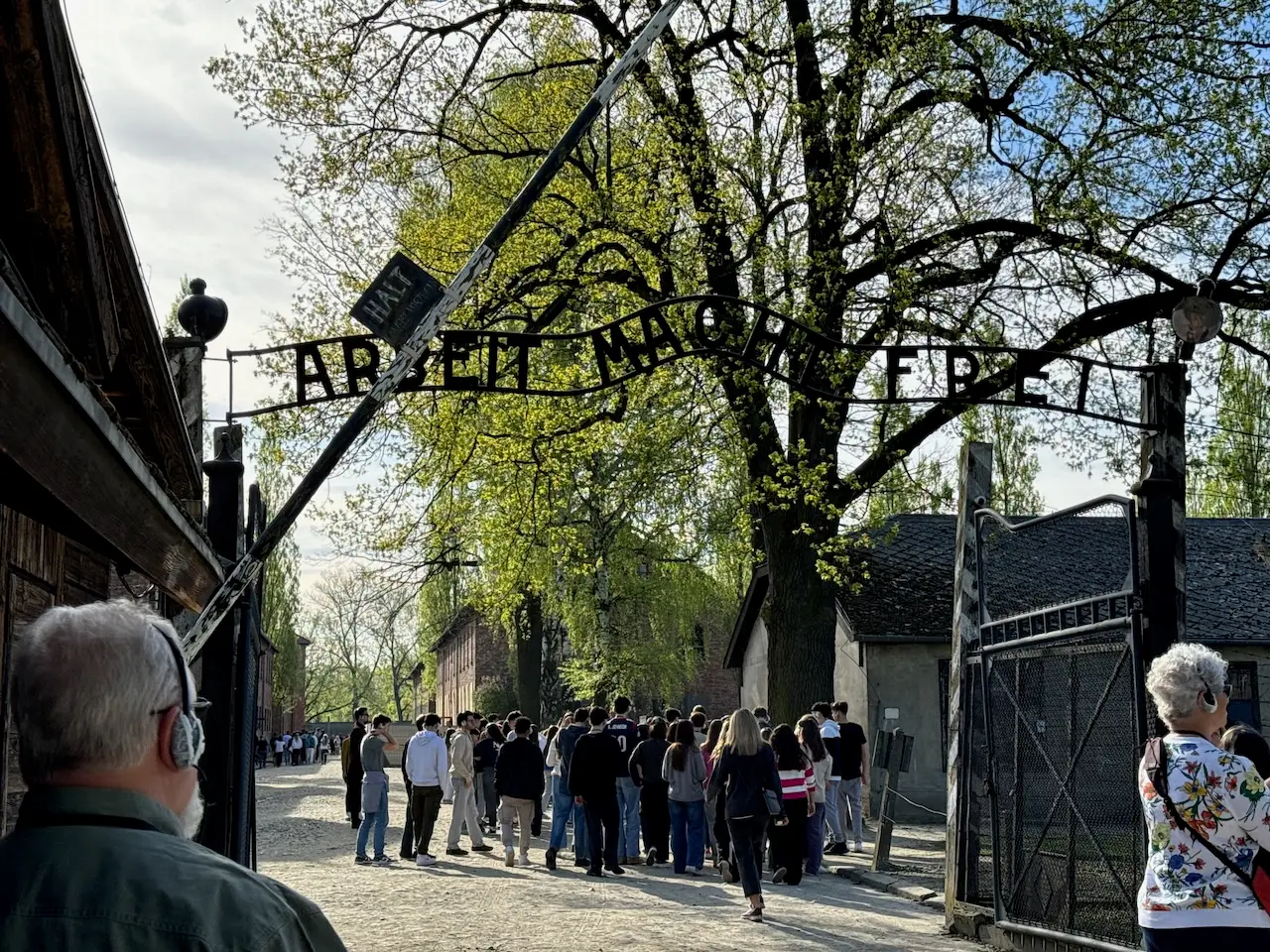I can hardly believe the graces around me. I get to experience two of my favorite things, history and faith, and I celebrate my favorite person on his 57th birthday. (Yes, Leroy.) Before telling you about our adventures, I have to stop and thank Leroy for making all of my dreams come true—even the usual dreams of visiting Nazi Germany and concentration camps. Today is so much more than just a Bucket List Day for me.
We started the day by attending Mass at St. Mary’s in the Krakow main square. (More candles and more prayers.) Today’s tour was the ultimate purpose of our pilgrimage to Poland. I have looked forward to this day since I was a young girl. We had the privilege of visiting the Auschwitz & Birkenau Concentration and Extermination camps. Auschwitz was established in 1940 and liberated (by the Russian Army) in January 1945. My mind is still spinning from the information we learned and the places we visited. We had an excellent guide at these locations, and I captured several stunning images. The local people in this area have a strong sense of responsibility to pass along the story so others never forget. Every Polish student must visit an extermination camp when they are around 14-15 years old. Also, it is illegal to say “Polish Concentration/Extermination Camps.” They must be referred to as “German Concentration/Extermination Camps.” (Even the camps which are located inside the Polish borders.)
In March 1933, the first concentration camp, Dachau, opened outside of Munich, Germany. Nazi officials established more than 44,000 incarceration sites during the time of the Third Reich. There were 23 main concentration camps and six extermination camps.
Upon entering the Auschwitz facility, you follow a hallway that is designed to replicate the path into the gas chamber. It is brightly lit and plain, but the most significant part of the experience is hearing the names of the victims read through the speakers. I tried to go in without expectation but was surprised to find beauty and serenity. Despite the horrors of its history, Auschwitz/Birkenau has become a profound monument to remember both victims and survivors. There is a strong sense of somber reverence, but it is peaceful, too. Forty kilometers of land surrounds Auschwitz, known as “The Zone of Interest,” which looks and sounds exactly as it is depicted in the movie of the same name. The section known as “Canada” was destroyed by the Nazis before the camp’s liberation. We also learned that Auschwitz was the only camp that used tattoos for prisoner identification. The punishment segment of Auschwitz was particularly horrifying. There were three types of cells: Standing (3 people), Dark (30 people), and Starvation. St. Maximilian Kolbe lasted two weeks in the starvation cell. He was murdered by an injection of carbolic acid into his heart. The courtyard between the two cell blocks was also used for torture and murder. There were more than 5,000 people who died on “The Death Wall.” In one display, there is a pile of almost two tons of hair shaved from more than 40,000 people. The hair was sold to German companies to make raw materials and felt. This display was overwhelming for me, and I had to leave early.
Birkenau was particularly shocking just by the sheer size of the place. It is 54 square miles or 345+ acres. The original barns were built to house 50 horses but contained 400-700 prisoners. There were 300 barracks in total. The Germans blew up the crematoria in January 1945 (to hide the evidence), but traces remain. When operating, each gas chamber could kill 2,000 people in 20 minutes. There were 7,000 prisoners liberated, and more than 2,000 died immediately after. The prisoners spoke 23 different languages, and they are remembered with a monument that includes this saying in each language: “Forever let this place be a cry of despair and a warning to humanity where the Nazis murdered about one and a half million men, women and children, mainly Jews from various countries of Europe.”
Members of the Sonderkommandos were Jewish prisoners who were forced to perform a variety of duties in the camp. One of these jobs was that of “Scheiss Commando,” literally “Shit Commando.” They were responsible for cleaning the toilets at Birkenau. Our tour guide explained that this was one of the best jobs in the camp. The Sheiss Commando was warm in the winter and out of the sun in the summer. They were allowed additional bathing privileges and could use the toilet whenever they wanted. Also, the German Nazis were germaphobes. They kept far away from this group of prisoners to avoid contamination. (And thus spared the members from additional brutality.
We attended a traditional Jewish dinner with Klezmer Folklore music and dancing in the evening. Raisins are typical Jewish food. Leroy does not care for raisins, so we’ll celebrate his birthday later in the week.































